| Some History Jacobs and Sweetgrass Farm |
||||||||||||
|---|---|---|---|---|---|---|---|---|---|---|---|---|
ABOUT JACOBS Jacob sheep are a unique, spotted, multiple horned sheep breed that attracts attention wherever they go. In the United States, they are raised primarily to support conservation of a heritage livestock breed, for production of handspinning wool, and as easy-keeping additions to small family farms. Jacobs are always white with either black or brownish gray (“lilac”) spots. Both rams and ewes have either 2, 4, or more rarely 6 horns. They are a relatively small breed, hardy and long-lived. Ewes generally have strong mothering instincts, and far more often than not lamb with no assistance. Handspinners and other fiber artists are attracted to their lofty, medium-textured and multi-colored wool. |
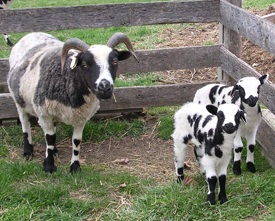 |
|||||||||||
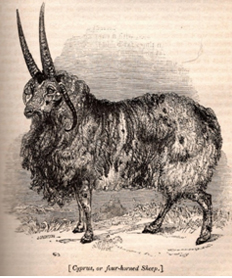 |
JACOB SHEEP HISTORY Much has been written about the origins of Jacob sheep, which were described as a distinct breed in Great Britain as early as the 1700’s, although in early days they went by a variety of names. While many of the original British Jacobs were imported from Spain, it appears likely that they originated in the eastern Mediterranean (including Persia, Syria, and Cyprus). Termed “park sheep” in Britain in reference to their ornamental use on large country estates or “parks,” they were bred for decades before a breed registry was established in 1969 by the British Jacob Sheep Society. At the left is an image of a Jacob-like Sheep from the 1837 book, Sheep: Their Breeds, Management, and Diseases by William Youatt. This book describes this as a fat-tailed sheep breed (which Jacobs are not) found on Cyprus, and notes that they were often polycerate. It is likely that Jacob sheep arose from various sheep in parts of the eastern Mediterranean region that eventually traveled to Spain and from there to Great Britain. Sometime in the 1950’s and early 1960’s, there were a limited number of imports of Jacobs to the U.S. and Canada as documented by Ingrid Painter in her book Jacob Sheep in America. Additional imports in the late 1960’s and 1970’s primarily to the Eastern US and Canada added to the population of American Jacobs. Further importations were prohibited due to concerns with bio diversity and the potential spread of disease. By 1988-89, several early breeders of Jacobs in the U.S. organized the Jacob Sheep Breeders Association (JSBA), defined a standard for American Jacobs, and established the current breed registry. While other registries have also been established (with similar goals but differing registration procedures), JSBA remains by far the largest and most active registry of American Jacob Sheep. |
|||||||||||
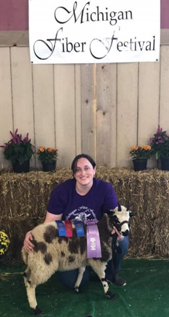 Our niece, Samantha Bostwick showing one of our ewes at the Michigan Fiber Fest |
SWEETGRASS JACOBS We were very fortunate to be able to purchase a Jacob ewe at the 1987 American Minor Breeds Conservancy show and sale at the St. Joseph County Fair, here in Michigan, from Barb Barraclough of Washington State. And we returned to that event the following year, where Barb and Ingrid Painter helped us select a ram, and invited us to the meeting of Jacob breeders from across the country- convened to discuss formation of a breed association (which became JSBA). Joe and I were too new and inexperienced to add much to the discussion, but we learned a great deal. It was not easy to locate breeding stock when our flock was new (pre-internet!). We started slowly, but in 1990, Fieldwood Farm – owned by Mrs. David Rockefeller – advertised the sale of about a dozen ewe lambs representing several import bloodlines. We thought they might be out of our reach, but the managing shepherdess – Suzanna Davy – was kind and helpful, and eventually we drove to New York in our old pickup and brought three beautiful ewes home. The addition of those ewes really got us started. Our Sweetgrass flock has been built and maintained primarily by keeping desirable ewe lambs bred here, while bringing in rams from many different breeders. JSBA has made an enormous difference in our ability to build a flock by providing both information and contact with other breeders. When our daughter, Jamie, joined 4-H, we learned about sheep management and showing alongside her. And discovered the value of showing -- not so much for the ribbons but to learn from the opinions of expert judges, and to introduce the breed to an enthusiastic audience. Eventually, we began to sell both lambs and wool at Michigan Fiber Festival and other events. |
|||||||||||
AMERICAN JACOBS NOW The number of Jacobs in the U.S. has grown significantly, although they are still considered “Threatened” by the Livestock Conservancy (less than 1000 registrations in the U.S. per year). JSBA registered 650 Jacobs in 2020, and as of early 2021 the Association has approximately 200 members. We currently have about 50 sheep in the Sweetgrass flock, with 30 brood ewes at this time. Since starting the flock, we think that the overall consistency and quality of our flock has improved, including wool quality. However, we still strive to maintain the heritage appearance and character of the breed. Jacobs are regular participants in many wool shows and festivals, as well as state and local fairs. They are included in the group of heritage wool breeds recognized by the Livestock Conservancy’s “Shave ‘em to Save ‘em Program.
|
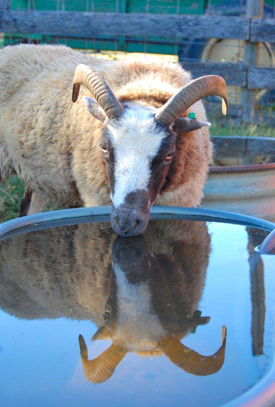 |
|||||||||||
|
||||||||||||
THE JACOB SHEEP BREEDERS ASSOCIATION www.jsba.org Browse the web pages to learn about Jacobs and to find breeders near you (see the Members Listing.)Join to register your Jacobs, and to interact with your fellow breeders. |
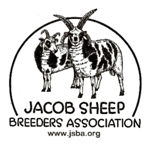 |
|||||||||||
THE LIVESTOCK CONSERVANCY TLC supports conservation of heritage livestock breeds and maintains a conservation priority list based on the relative rarity of those breeds. TLC considers American Jacob Sheep to be a distinct breed that is currently rated as “Threatened.” TLC also organized the Shave ‘Em to Save ‘Em program to promote use of heritage breed wool by fiber artists. |
|
|||||||||||
| MICHIGAN SHEEP PRODUCERS ASSOCIATION www.MiSheep.org MSPA provides support for all sheep breeders in Michigan, and welcomes commercial producers, small flocks, and wool producers alike. Many other states have similar organizations |
 |
|||||||||||
| THE MICHIGAN FIBER FESTIVAL www.michigan fiber festival Every August, Michigan Fiber Festival attracts hundreds of fleece animals, fiber artists, workshop teachers and vendors to Allegan Michigan. Check out the web pages, and if you attend make sure to find our Sweetgrass Jacobs booth right next to the JSBA booth, look for our animals in the barn, and say hello. |
 |
|||||||||||
|
||||||||||||

